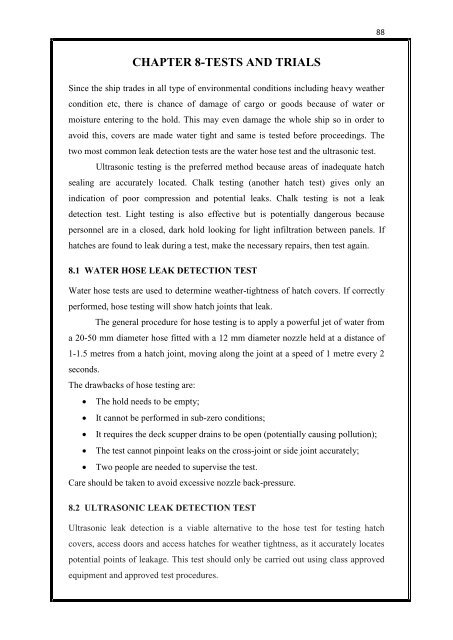Single pull macgregor type hatch cover.pdf - Cochin University of ...
Single pull macgregor type hatch cover.pdf - Cochin University of ...
Single pull macgregor type hatch cover.pdf - Cochin University of ...
Create successful ePaper yourself
Turn your PDF publications into a flip-book with our unique Google optimized e-Paper software.
CHAPTER 8-TESTS AND TRIALS<br />
Since the ship trades in all <strong>type</strong> <strong>of</strong> environmental conditions including heavy weather<br />
condition etc, there is chance <strong>of</strong> damage <strong>of</strong> cargo or goods because <strong>of</strong> water or<br />
moisture entering to the hold. This may even damage the whole ship so in order to<br />
avoid this, <strong>cover</strong>s are made water tight and same is tested before proceedings. The<br />
two most common leak detection tests are the water hose test and the ultrasonic test.<br />
Ultrasonic testing is the preferred method because areas <strong>of</strong> inadequate <strong>hatch</strong><br />
sealing are accurately located. Chalk testing (another <strong>hatch</strong> test) gives only an<br />
indication <strong>of</strong> poor compression and potential leaks. Chalk testing is not a leak<br />
detection test. Light testing is also effective but is potentially dangerous because<br />
personnel are in a closed, dark hold looking for light infiltration between panels. If<br />
<strong>hatch</strong>es are found to leak during a test, make the necessary repairs, then test again.<br />
8.1 WATER HOSE LEAK DETECTION TEST<br />
Water hose tests are used to determine weather-tightness <strong>of</strong> <strong>hatch</strong> <strong>cover</strong>s. If correctly<br />
performed, hose testing will show <strong>hatch</strong> joints that leak.<br />
The general procedure for hose testing is to apply a powerful jet <strong>of</strong> water from<br />
a 20-50 mm diameter hose fitted with a 12 mm diameter nozzle held at a distance <strong>of</strong><br />
1-1.5 metres from a <strong>hatch</strong> joint, moving along the joint at a speed <strong>of</strong> 1 metre every 2<br />
seconds.<br />
The drawbacks <strong>of</strong> hose testing are:<br />
� The hold needs to be empty;<br />
� It cannot be performed in sub-zero conditions;<br />
� It requires the deck scupper drains to be open (potentially causing pollution);<br />
� The test cannot pinpoint leaks on the cross-joint or side joint accurately;<br />
� Two people are needed to supervise the test.<br />
Care should be taken to avoid excessive nozzle back-pressure.<br />
8.2 ULTRASONIC LEAK DETECTION TEST<br />
Ultrasonic leak detection is a viable alternative to the hose test for testing <strong>hatch</strong><br />
<strong>cover</strong>s, access doors and access <strong>hatch</strong>es for weather tightness, as it accurately locates<br />
potential points <strong>of</strong> leakage. This test should only be carried out using class approved<br />
equipment and approved test procedures.<br />
88

















